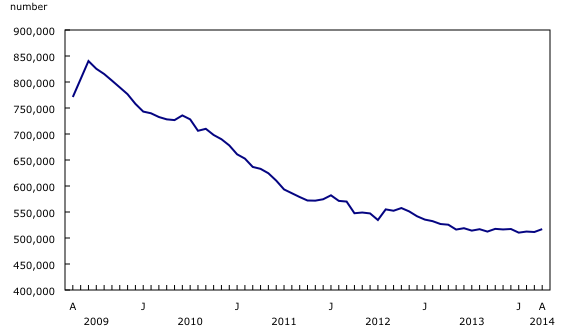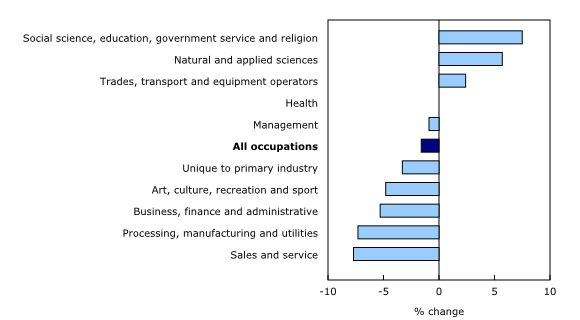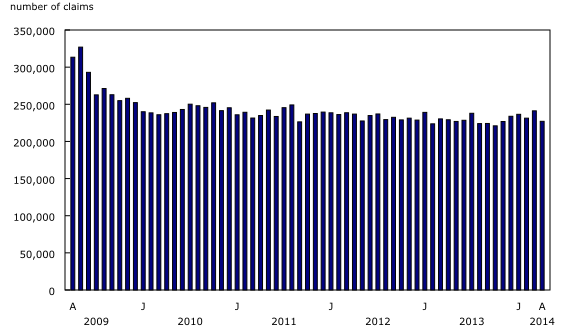Employment Insurance, April 2014
Archived Content
Information identified as archived is provided for reference, research or recordkeeping purposes. It is not subject to the Government of Canada Web Standards and has not been altered or updated since it was archived. Please "contact us" to request a format other than those available.
Released: 2014-06-19
The number of people receiving regular Employment Insurance (EI) benefits totalled 517,100 in April, up slightly (+1.1% or +5,600) from March. The number of beneficiaries has been relatively unchanged for almost a year, following a long-term downward trend that began in the summer of 2009.
Quebec, Nova Scotia and New Brunswick saw increases in the number of beneficiaries, while Newfoundland and Labrador posted a decline. There was little change in the other provinces.
The change in the number of regular EI beneficiaries reflects various situations, including people becoming beneficiaries, people going back to work, and people no longer receiving regular benefits.
Provincial and metropolitan area overview
In Quebec, the number of people receiving regular benefits increased for the third consecutive month, up 4.3% in April, continuing an upward trend that began at the start of the year. All six metropolitan areas in the province had more beneficiaries, with Sherbrooke (+9.0%) and Montréal (+5.4%) posting their third consecutive month of increases. There were 57,600 beneficiaries in Montréal in April, the highest level since November 2012.
The number of beneficiaries in Nova Scotia rose by 2.7%, following four consecutive monthly declines. Halifax saw a 1.4% increase in the number of people receiving benefits in April, continuing an upward trend that began in the fall of 2013.
New Brunswick had slightly more beneficiaries in April (+1.3%), leaving it at a level similar to that seen in the fall of 2013. In Saint John, there was a marked increase in the number of beneficiaries (+13.0%), following four consecutive monthly declines.
In Newfoundland and Labrador, the number of beneficiaries fell 2.1% in April, continuing the downward trend of recent months. All of the April decline occurred outside the metropolitan area of St. John's.
The number of people receiving regular EI benefits in April was little changed in Ontario and in all Western provinces, but this was not the case in some metropolitan areas within these provinces.
In Ontario, 6 of 15 metropolitan areas had more beneficiaries in April, with the largest increases in Windsor (+3.1%) and Greater Sudbury (+3.0%). At the same time, Oshawa and Toronto posted declines of 5.7% and 2.1% respectively. The number of beneficiaries in Toronto was down for the second month in a row, at 57,900 in April.
The number of beneficiaries declined 1.4% in Saskatoon, 1.9% in Edmonton and 1.7% in Kelowna.
Regular Employment Insurance beneficiaries by occupation
From March to April, there were more beneficiaries among people whose last occupation was in trades, transport and equipment operation (+3.1%), especially those who had worked in construction trades and "other" trades occupations. The latter group includes occupations such as machinists, mechanics and electricians.
In April, there was also an increase in the number of beneficiaries for those who were in processing, manufacturing and utilities (+1.4%), the bulk of which was among those who had worked as machine operators and assemblers in manufacturing, including supervisors.
In the 12 months to April, the number of beneficiaries among all occupation groups was down by 1.6%, with five occupation groups recording declines, ranging from 3.3% in primary industry to 7.7% in sales and service.
At the same time, the number of beneficiaries increased among people who had worked in three occupational groups.
There was a 7.5% increase in the social science, education, government service and religion group, mainly attributable to teachers and professors. There were also more beneficiaries among those whose last occupation was in natural and applied sciences (+5.7%), as well as in trades, transport and equipment operation (+2.4%). For the latter group, most of the increase in the 12 months to April was among those who had worked in construction trades and "other" trades occupations.
Employment Insurance beneficiaries in major demographic groups
In each of the three broad age groups, more men received benefits in April, especially those aged 15 to 24, who saw an increase of 3.9%. In contrast, the number of women aged 15 to 24 receiving benefits fell for the third month in a row, down slightly by 1.1%, while there was little change for women aged 25 to 54 and those 55 and over.
On a year-over-year basis, the number of women aged 15 to 24 and 25 to 54 receiving benefits continued to fall faster than men in the same age groups. In contrast, the number of beneficiaries increased for the third consecutive month among men aged 55 and over, up 2.6% from 12 months earlier, while it was virtually unchanged for women in the same age group.
Fewer Employment Insurance claims in April
The number of claims provides an indication of the number of people who could become beneficiaries.
Following an increase in March, the number of initial and renewal claims fell by 5.8% in April.
In April, the number of Employment Insurance claims declined in seven provinces. Claims fell in Ontario and Alberta, down 12.6% and 12.0% respectively, following increases of similar magnitudes the previous month. Claims also fell in Saskatchewan in April, down 11.7%.
Relatively smaller declines were observed in British Columbia (-3.1%), Newfoundland and Labrador (-3.1%), Prince Edward Island (-2.2%) and Quebec (-1.2%).
At the same time, claims rose by 7.8% in Manitoba, following a decline of similar magnitude the previous month. There were also increases in New Brunswick and Nova Scotia (+5.4% and +3.7% respectively), following two consecutive monthly declines.
Note to readers
Regular Employment Insurance (EI) benefits are available to eligible individuals who lose their jobs and who are available for and able to work, but cannot find a job. To receive EI benefits, individuals must first submit a claim. The number of claims provides an indication of the number of people who could become beneficiaries.
There is always a certain proportion of unemployed people who do not qualify for benefits. Some unemployed people have not contributed to the program because they have not worked in the past 12 months or their employment is not insured. Other unemployed people have contributed to the program but do not meet the eligibility criteria, such as workers who left their job voluntarily or those who did not accumulate enough hours of work to receive benefits.
All data in this release are seasonally adjusted. For information on seasonal adjustment, see Seasonally Adjusted Data – Frequently Asked Questions.
EI statistics are produced from administrative data sources provided by Service Canada and Employment and Social Development Canada. These statistics may, from time to time, be affected by changes to the Employment Insurance Act or administrative procedures.
The number of regular EI beneficiaries and the number of claims received for the current and previous month are subject to revision.
The number of beneficiaries is a measure of all people who received EI benefits from April 13 to 19. This period coincides with the reference week of the Labour Force Survey (LFS). However, initial and renewal claims data are for the entire month.
EI statistics indicate the number of people who received EI benefits, and should not be confused with LFS data, which provide information on the total number of unemployed people.
Data tables are also now available online. From the Browse by key resource module of our website under Summary tables, choose Subject, then Labour.
Data on Employment Insurance for May will be released on July 24.
Contact information
For more information, contact us (toll-free 1-800-263-1136; 514-283-8300; infostats@statcan.gc.ca).
To enquire about the concepts, methods or data quality of this release, contact Lahouaria Yssaad (613-951-0627; lahouaria.yssaad@statcan.gc.ca), Labour Statistics Division.
- Date modified:




